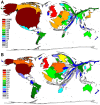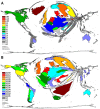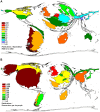Respiratory syncytial virus: a systematic scientometric analysis of the global publication output and the gender distribution of publishing authors
- PMID: 28751483
- PMCID: PMC5577886
- DOI: 10.1136/bmjopen-2016-013615
Respiratory syncytial virus: a systematic scientometric analysis of the global publication output and the gender distribution of publishing authors
Abstract
Objective: Worldwide, the respiratory syncytial virus (RSV) represents the predominant viral agent causing bronchiolitis and pneumonia in children. To conduct research and tackle existing healthcare disparities, RSV-related research activities around the globe need to be described. Hence, we assessed the associated scientific output (represented by research articles) by geographical, chronological and socioeconomic criteria and analysed the authors publishing in the field by gender. Also, the 15 most cited articles and the most prolific journals were identified for RSV research.
Design: Retrospective, descriptive study.
Setting: The NewQIS (New Quality and Quantity Indices in Science) platform was employed to identify RSV-related articles published in the Web of Science until 2013. We performed a numerical analysis of all articles, and examined citation-based aspects (eg, citation rates); results were visualised by density equalising mapping tools.
Results: We identified 4600 RSV-related articles. The USA led the field; US-American authors published 2139 articles (46.5%% of all identified articles), which have been cited 83 000 times. When output was related to socioeconomic benchmarks such as gross domestic product or Research and Development expenditures, Guinea-Bissau, The Gambia and Chile were ranked in leading positions. A total of 614 articles on RSV (13.34% of all articles) were attributed to scientific collaborations. These were primarily established between high-income countries. The gender analysis indicated that male scientists dominated in all countries except Brazil.
Conclusions: The majority of RSV-related research articles originated from high-income countries whereas developing nations showed only minimal publication productivity and were barely part of any collaborative networks. Hence, research capacity in these nations should be increased in order to assist in addressing inequities in resource allocation and the clinical burden of RSV in these countries.
Keywords: Citation; Economic benchmarks; Gender; Publication; Respiratory Syncytial Virus; Scientometry.
© Article author(s) (or their employer(s) unless otherwise stated in the text of the article) 2017. All rights reserved. No commercial use is permitted unless otherwise expressly granted.
Conflict of interest statement
Competing interests: None declared.
Figures








Similar articles
-
Rotavirus - Global research density equalizing mapping and gender analysis.Vaccine. 2016 Jan 2;34(1):90-100. doi: 10.1016/j.vaccine.2015.11.002. Epub 2015 Nov 21. Vaccine. 2016. PMID: 26611203
-
Global architecture of gestational diabetes research: density-equalizing mapping studies and gender analysis.Nutr J. 2016 Apr 4;15:36. doi: 10.1186/s12937-016-0154-0. Nutr J. 2016. PMID: 27044432 Free PMC article. Review.
-
Ectopic pregnancy: exploration of its global research architecture using density-equalising mapping and socioeconomic benchmarks.BMJ Open. 2017 Oct 11;7(10):e018394. doi: 10.1136/bmjopen-2017-018394. BMJ Open. 2017. PMID: 29025848 Free PMC article.
-
Scientometric analysis and mapping of scientific articles on Behcet's disease.Int J Rheum Dis. 2013 Apr;16(2):185-92. doi: 10.1111/1756-185X.12087. Int J Rheum Dis. 2013. PMID: 23773643
-
Biliary atresia: a scientometric analysis of the global research architecture and scientific developments.J Hepatobiliary Pancreat Sci. 2019 Jun;26(6):201-210. doi: 10.1002/jhbp.628. Epub 2019 May 21. J Hepatobiliary Pancreat Sci. 2019. PMID: 30980482 Review.
Cited by
-
A landscape review of the published research output relating to respiratory syncytial virus (RSV) in North & Central America and Europe between 2011-2015.J Glob Health. 2019 Jun;9(1):010425. doi: 10.7189/jogh.09.010425. J Glob Health. 2019. PMID: 31131100 Free PMC article. Review.
-
In silico comparative structural and compositional analysis of glycoproteins of RSV to study the nature of stability and transmissibility of RSV A.Syst Microbiol Biomanuf. 2023;3(2):312-327. doi: 10.1007/s43393-022-00110-x. Epub 2022 May 27. Syst Microbiol Biomanuf. 2023. PMID: 38013803 Free PMC article.
-
Coronavirus: An insight into global research until outbreak of COVID-19 and its implications for the future.J Glob Health. 2020 Dec;10(2):020508. doi: 10.7189/jogh.10.020508. J Glob Health. 2020. PMID: 33110591 Free PMC article.
-
Research Trends and Collaboration Patterns on Polymyxin Resistance: A Bibliometric Analysis (2010-2019).Front Pharmacol. 2021 Oct 22;12:702937. doi: 10.3389/fphar.2021.702937. eCollection 2021. Front Pharmacol. 2021. PMID: 34744707 Free PMC article.
-
New quality and quantity indices in science (NewQIS): results of the first decade-project progress review.Scientometrics. 2019;121(1):451-478. doi: 10.1007/s11192-019-03188-8. Epub 2019 Jul 13. Scientometrics. 2019. PMID: 32214551 Free PMC article.
References
MeSH terms
LinkOut - more resources
Full Text Sources
Other Literature Sources
Molecular Biology Databases
